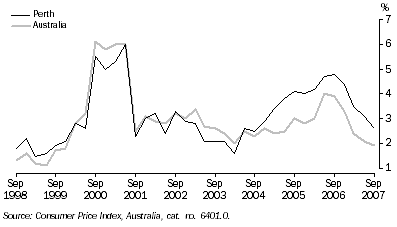 PRICES
PRICES
CONSUMER PRICE INDEX
Perth's Consumer Price Index (CPI) rose 0.6% in the September quarter 2007, less than half the rate of the previous quarter (1.4%) and slightly lower than national CPI growth (0.7%). A major contributor to Perth's slowing CPI growth was child care. The price of child care fell 32.2% in the September quarter 2007. This was due to the Child Care Tax Rebate being included as a rebate in calculating the "net" change in child care costs for the first time and the additional 10% indexation of the Child Care Benefit rates on top of the usual annual CPI indexation. Other notable contributions were lower prices for automotive fuel (down 2.7%), motor vehicles (down 0.8%), pharmaceuticals (down 4.2%) and towels and linen (down 9.6%).
The rise in Perth's CPI in the September quarter 2007 was mainly driven by the cost of overseas holiday travel and accommodation (up 6.7%) and fruit (up 9.4%). Prices were also notably higher for rents (up 2.0%), deposit and loan facilities (2.2%) and house purchase (up 0.8%).
CONSUMER PRICE INDEX (ALL GROUPS), Change from same quarter previous year

Perth's CPI rose 2.6% through the year to September quarter 2007, much lower than the rate of the previous period (3.1%), mainly due to price falls in fruit (down 16.2%), automotive fuel (down 4.1%), audio, visual and computing equipment (down 10.9%) and child care (down 24.1%). Perth's through the year growth was the third highest among Australian capital cities, behind Darwin (up 3.2%) and Brisbane (up 2.7%). The main contributors to Perth's CPI growth were rents (up 9.6%) and house purchase costs (up 3.8%).
Nationally, the CPI rose 1.9% through the year to September quarter 2007, slightly below the Reserve Bank of Australia's (RBA) medium-term target for consumer price inflation of 2-3 per cent. The RBA, however, accounts for temporary fluctuations in the CPI (such as changes in petrol prices) when it decides on changes to official interest rates. With this in mind, the RBA's measures of underlying inflation were both much higher than CPI inflation through the year (weighted mean up 3.1% and trimmed mean up 2.9%), mainly due to the exclusion of automotive fuel prices, which fell 6.7% over the period.
WAGE PRICE INDEX
Western Australia's Wage Price Index (WPI) of total hourly rates of pay (excluding bonuses) rose 1.8% in the September quarter 2007, following an increase of 1.7% in the previous quarter. The current quarter rise was the equal highest among the states and territories along with South Australia (1.8%) and surpassed national WPI growth of 1.3%. In Western Australia, private sector wages grew 2.2% and public sector wages were up 0.7%.
WAGE PRICE INDEX, Change from same quarter previous year

Western Australia's WPI increased 5.7% through the year to September quarter 2007, higher than the rise in the previous period (5.1%) and much higher than national wages growth (4.2%). The increase in Western Australia's WPI was the highest through the year growth since the series began in September 1997. Wages grew strongly in the industries of manufacturing (7.4%) and personal and other services (7.1%) and in the occupations of labourers and related workers (8.4%) and tradespersons and related workers (7.0%).
 Print Page
Print Page
 Print All
Print All